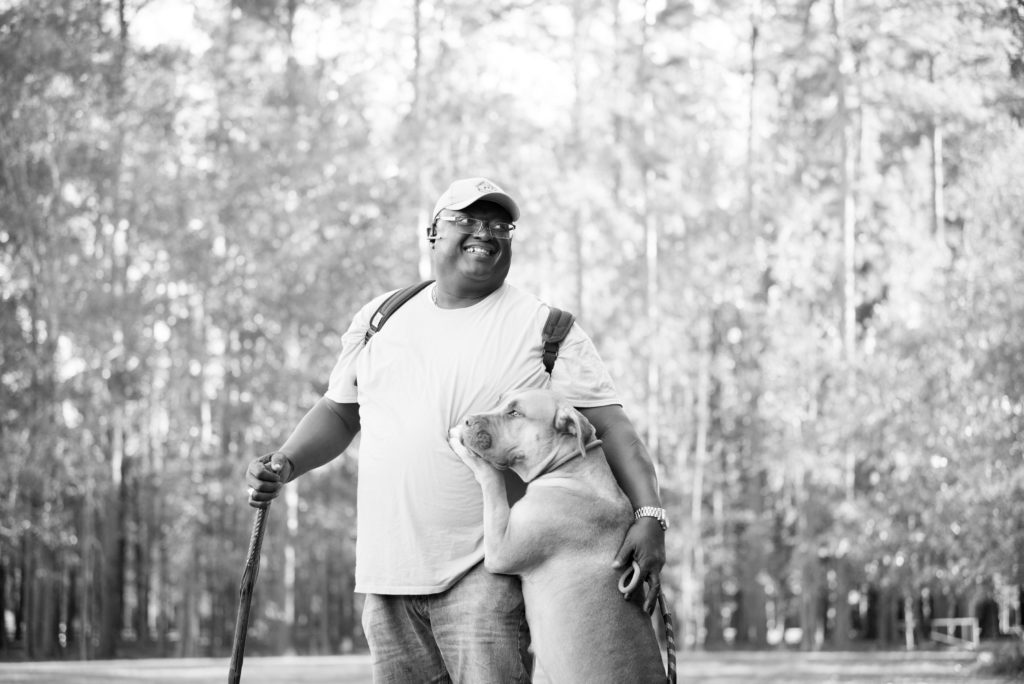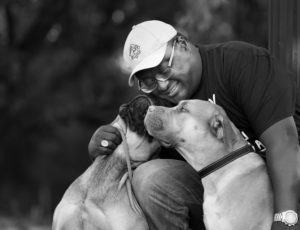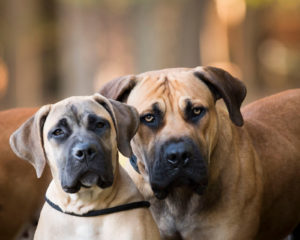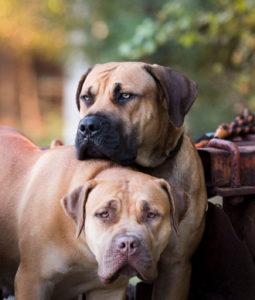Authentic South African Boerboels
The South African Boerboel Born Out of Adversity, Bred for Necessity.
The Foundation of IBK's Breeding Program
IBK Test For Common Health Issues
 These are the genetic health and orthopedic issues common in the South African Boerboel breed. SAS Subaortic Stenosis, DM Degenerative Myelopathy, HUU Hyperuricosuria, Wobblers Disease, CMR1 Canine Multifocal Retinopathy 1, MDR1 Multidrug Resistance 1, Food Allergies, Entropion, Ectropion, HD Hip Dysplasia and ED Elbow Dysplasia.
These are the genetic health and orthopedic issues common in the South African Boerboel breed. SAS Subaortic Stenosis, DM Degenerative Myelopathy, HUU Hyperuricosuria, Wobblers Disease, CMR1 Canine Multifocal Retinopathy 1, MDR1 Multidrug Resistance 1, Food Allergies, Entropion, Ectropion, HD Hip Dysplasia and ED Elbow Dysplasia.
IBK Breeds for Temperament
 There are three basic canine temperament groups: Assertive/Aggressive, Neutral, and Passive.
There are three basic canine temperament groups: Assertive/Aggressive, Neutral, and Passive.
In addition, there can be a mishmash of all three dog temperament types, depending on the situation. Objectively observe and decide which group or combination your puppy or dog fits. Then choose the proper amount and type of Environmental Socialization that your pup will need to be successful.
IBK Breeds for Conformation

Official Standard of the Boerboel
This is the AKC Boerboel Breed Standard in which IBK follows.
General Appearance: Historically the Boerboel developed as a general farm dog for the pioneers who settled in South Africa since the seventeenth century. These dogs were often the first line of defense against predators and were valuable in tracking and holding down wounded game. Old farmers told many a tale of the strength, agility, and courage of the Boerboel. The dangers and harsh conditions of southern Africa allowed only the fittest to survive. The protective character of the Boerboel is today still evident and is much sought after, as is the calm, stable and confident composure of the breed. The origin and purpose of the Boerboel should be understood to preserve the unique identity and qualities of the breed as a South African developed mastiff. Type, conformation, functional efficiency, and mentality are equally important in the evaluation of the Boerboel as a whole. The Boerboel is a large dog that is strong, confident, and muscular in appearance with powerful, free-flowing movement. When observing a Boerboel at play or work, standing or moving, it should show strength, suppleness, nimbleness, and agility. Size, Proportion, Substance: The preferred height for Dogs – 24 to 27 inches. Bitches – 22 to 25 inches. Balance, proportion, and sound movement are of utmost importance-more so than size. The body should have a greater total length than total height and the relation between the length and height should ideally be 10:9. Length of body is measured pro-sternum to farthest point of rump. Height is measured from the top of the shoulder blade to the ground. Depth of the chest reaches down to the point of the elbow, which is approximately half the total height at the withers. Front and rear angulation should be equal for proper balance. Dogs are characteristically of larger frame and heavier bone than bitches. Bitches are feminine, but without weakness of substance or structure. Serious fault – Severely out of proportion and balance. Reversal of sex characteristics. Head: The head is an impressive and a distinctive feature of the Boerboel. It should be blocky, broad, deep, square and muscular, with well filled cheeks and in proportion to the body. Moderate wrinkling is observed over the forehead when the dog shows interest. The skull is square, flat and muscular. The zygomatic arch (cheek bone) is well muscled, but not too prominent. The stop is visible, gradually sloping. It should not be steep. The muzzle is broad, deep and narrows slightly towards the nose, straight and almost on a parallel plane with the skull. The muzzle measures slightly more than a third of the total length of the head. The nostrils are completely black, large and widely spaced, with the septum (vertical line) of the nose perpendicular to the lower jaw. The jaws are strong, deep and wide, and taper slightly to the front. The teeth are white, strong, correctly spaced with complete dentition preferred. Ideally the dog should have a scissors bite. An under bite of up to ¼ inch is acceptable. The upper lip is loose and fleshy. Under the nose, the end of the upper lip must touch the top of the bottom lip. Viewed in profile, the flews must not extend below the lowest level of the jaw bone. The lower lip is moderately tight without excessive jowls. The eyes are medium sized, neither protruding or receding, forward facing and widely spaced, with an intelligent expression. The eyelids must be tight fitting with complete pigmentation, showing no structural weakness. The color of the eye is preferably dark brown but all shades of brown (preferably darker than the coat) are acceptable. The ears are medium sized, V shaped, hanging forward, medium leather, tapering to a rounded point that reaches almost down to a line extending from the mouth. They are set wide and are carried close to the head. When the dog is attentive the top of the ears and the skull give the appearance of widening. The facial expression should be intelligent and attentive. Serious fault – Yellow (bird of prey) eyes. Disqualifications – Blue eye(s), entropion or ectropion, over bite, under bite of more than ¼ inch, wry mouth, prick ears. Neck, Topline, Body: The neck is powerful, of medium length, and forms a muscular arch. It flows smoothly into the sloping shoulders, gradually increasing in width from the head to the shoulders. (In the female the muscles are less accentuated but should remain in balance with the head and body). The dewlap is noticeable but disappears towards the sternum. The topline is firm and level, extending in a straight line from behind the withers to the croup. The back remains horizontal to the ground while the dog is moving or standing. The underline of a mature dog has a slight tuck-up. The body is blocky, muscular and solid, with good depth and width. The back is broad and straight, with pronounced muscles. The ribcage is well sprung and well filled behind the shoulder blades. The transitions between the chest, loin and rump are well filled and flowing. The loin is strong and muscular, and only slightly narrower than the ribcage and rump. The croup is broad, flat and strong, with well-defined musculature. Its height should not exceed the height at the shoulders. The tail is thick and set fairly high. It should be well covered with hair and without kink. The tail may be docked or left undocked, both being equivalent. If docked, tails are traditionally docked at the third or fourth caudal vertebrae. The undocked tail should reach to the hocks when the dog is standing and be carried with a slight curve upwards when excited or moving. Tail set is more important than the length. Forequarters: The forelegs are strong boned, with well-defined muscles. Viewed from the side the forearm should be vertical from the elbow to the pastern. When viewed from the front they should be parallel to each other, not bowed or with toes turning inward. Elbows should be held close to the body. Length of the foreleg to the elbow is approximately 50 percent of the dog’s height at the shoulder. The chest is broad, deep and wide with well-sprung ribs and strong developed pectoral muscles. The shoulders are moderately sloping, powerful and muscular, with no tendency to looseness. The shoulder blade is long with moderate angulation. The upper arm is equal in both length and angulation to the shoulder blade. The pastern is short, thick and strong and with a slight slope when viewed from the side. The front feet point straight forward, are large, round, strongly boned and compact. The toes are well arched, with short, preferably black toenails and protected by hair in between. Front dewclaws may be removed. The pads are thick, tough and black. Hindquarters: The hindquarter is sturdy and muscular. The hind legs are strong boned. The stifle should be sound, strong and moderately angulated and in balance with the forequarters, to support the powerful propulsion from the hindquarters during movement. The upper thighs are broad, deep and muscular as seen from the side and the rear. The lower thighs have well defined muscles and show substance down to the hocks. The metatarsus is broad, relatively short and perfectly upright. The hind feet point straight forward. Rear dewclaws, if any, are generally removed. Coat and Color: The coat is short, dense, smooth and shiny. The skin is thick and loose but fits smoothly. Skin is well pigmented. The recognized colors / patterns are with or without a mask; however, the black mask is desirable. Red, Brown, Reddish Brown, Fawn, Cream, brindle in any accepted color and Irish Marked. Limited clear white patches on the legs and the fore chest are permissible. Piebald, a white dog, with colored markings, total area of white may not exceed 33 percent or is disqualified, ticking or spots within the white to be disqualified. The Boerboel is well pigmented, especially on the lips, palate, the skin and hair around the eyes, nose leather, paw pads, toenails, the anus and the skin and hair around the genitals. Disqualifications – Blue colored (Powder Coat) dogs, any base color not listed, long coat, and nose leather in any color other than black. Movement: Movement is the ultimate test for correct conformation. The Boerboel is the most agile of the molosser breeds and it should be reflected in its movement. The Boerboel’s movement is powerful and with purpose. The front reach should complement a strong rear drive. The legs and body should move in line front to rear. As speed increases the legs will converge under body towards a center line. The back remains firm and strong and without excess body roll. Temperament: The Boerboel is a dominant and intelligent dog with strong protective instincts and a willingness to please. When approached is calm, stable and confident, at times displaying a self-assured aloofness. He should recognize a threat or lack thereof. He is loving with children and family. An aggressive or belligerent attitude towards other dogs should not be faulted. Boerboels that are shown in competition should be trained to allow examination. Faults: The foregoing description is that of the ideal Boerboel. Any deviation that detracts from the above-described dog must be penalized to the extent of the deviation. Severely out of proportion and balance. Reversal of sex characteristics. Yellow (bird of prey) eyes. Disqualifications: Blue Eye(s). Entropion or ectropion. Undershot greater than ¼ inch or overshot bite. Wry mouth. Prick ears. Blue colored (Powdered Coat) dogs, white exceeding more than 33 percent of the color on a dog, ticking or spots within the areas of white. Any base color not listed. Long coat. Nose leather in any color other than black. Approved July 13th, 2020 Effective September 30th, 2020

Integrity Boerboel Kennels, INC
Pride ourselves on providing integrity, honesty and full transparency of our breeding program. We provide Embark DNA testing, Orthopedic Foundation For Animals(OFA) health checks on all our Boerboel’s parents and litters. Our puppies also undergo personality testing and socialization exposure before they go to their permanent homes.
Testimonials
Again, thank you for giving us a staple to our family and letting us join the IBK family!”
Frank and Megan Wells
Owner of IBK Daisy
IBK has bred a wonderful dog, and I would recommend anyone who’s ready and has done their homework on the breed. “
Jackie Omollo Owner of IBK ZULU



